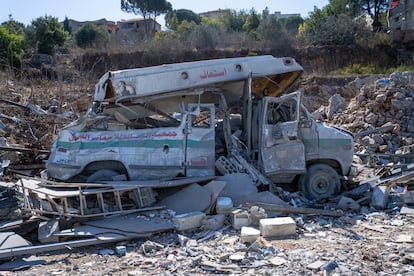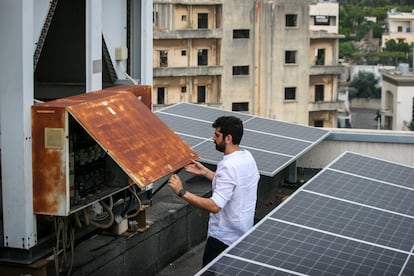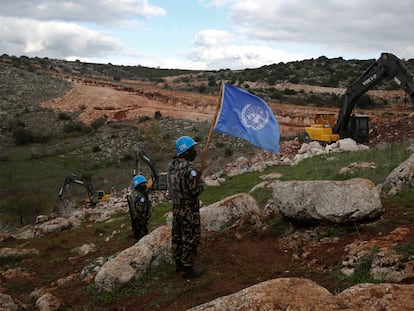Israel replicates Gaza model in Lebanon: Ambulances and hospitals are legitimate targets
Six percent of those killed in the country by Israeli fire in the last year are emergency personnel. The number has now reached 168, mainly medical workers and firefighters
Six percent of Lebanese people killed by Israeli fire in the past year are emergency personnel: 168 out of 2,710, medical workers and firefighters, above all. Not as “collateral damage,” but as targets, with missiles aimed at the ambulances in which they go to treat the victims of a bombing or directly at the post where they are on guard. The Israeli army has also put eight hospitals out of service and partially destroyed another seven, in the north, center and south of the country. These are all figures from the Lebanese Ministry of Health, whose head, Firas Abiad, accused Israel last week of carrying out a “deliberate and systematic” campaign with the aim of “sowing chaos and panic” and “creating problems for the authorities.”
There have been 58 airstrikes against hospitals and clinics, 158 against ambulances, and 72 against firefighting or rescue vehicles since Hezbollah began hostilities on October 8, 2023, but they have been overwhelmingly concentrated in the last few weeks of the offensive. The data and testimonies indicate that the Israeli army has applied to its northern neighbor (which it invaded on October 1) the same strategy that it has been applying in Gaza for more than a year: treating emergency personnel as legitimate targets by accusing them of being part of the enemy or carrying weapons in violation of the rules of war, and designating hospitals as enemy hideouts.
The small difference between the dead (168) and the wounded (275) reinforces the theory that they are the target, as the gap is usually much broader. Hussein Fakih was close to joining the first figure. He wound up in the second and tells his story in a small voice from his bed in the Nabih Berri Governmental University Hospital in Nabatieh, a once vibrant city of 40,000 inhabitants in the south of Lebanon that now appears almost deserted.

Fakih is in charge of the State Civil Defense in the region, which carry out emergency medical care and firefighting duties. He went out to treat the victims of three attacks near a civil defense post. He says that after rescuing a seriously injured colleague who died on arrival at the hospital, they saw another attack, so they headed in that direction.
“We sent our vehicles out. Some were putting out the fire, others were clearing the rubble, others were rescuing the wounded. It was a horrible scene. There was fire and body parts everywhere,” he recalls. They split up and, as they were regrouping, another missile fell, this one about 10 meters from where they were. “We couldn’t see each other anymore. There was smoke everywhere. Once it cleared, we saw that some of us were wounded. I had glass and debris all over my body. I lost consciousness for a while and the team took me to the hospital. Only today can I speak again,” he says, tired and sedated.
There is a key word that, in practice, means a veto over the medical care of the wounded: coordination. In other words, the green light from the Israeli military authorities for ambulances and firefighters to leave. “Sometimes they arrive in five minutes; sometimes in five hours,” explains Shafi Fouani, medical director of the Lebanese People’s Aid hospital in Nabatieh. “On other occasions,” he adds, “they say no. Or they don’t respond at all.”
The Lebanese Red Cross is always waiting for them, and they go out in convoy with the Lebanese army. They contact the Israeli side, usually through the U.N. mission in southern Lebanon (UNIFIL), and wait for their green light, even if they lose critical time for care. Their ambulances have suffered some attacks, but they are the least-affected organization.
In addition to the Lebanese Red Cross and the Civil Defense, there are the emergency services run by the two major Shia factions in the country: Hezbollah, the main target of the Israeli offensive, and Amal. The majority of the fatalities among emergency personnel (more than 80) are from Hezbollah’s Islamic Committee for Health. Israel even bombed one of its headquarters in central Beirut, killing nine of its medical workers, and an ambulance parked in front of the state hospital in Marjayoun, killing seven.
Another two dozen of the dead belong to Al Risala, the Amal boy scouts. In both cases, these are organizations that mix staff and volunteers and have agreements with the Ministry of Health. When they could, they went to help wounded Hezbollah fighters. Israel had already had them in its sights, in fact, in the previous 11 months of low-intensity war, which was limited to the south of the country, with much more surgical bombings and unwritten rules of the game that have been blown to pieces in the current conflict.
Some paramedics, on condition of anonymity, describe how they have saved the lives of colleagues or seen them die. They agree that they often receive a warning bombardment when they are on their way, just a few dozen meters ahead, to force them to turn back. Others speak of the “second blow”: the one that comes when they arrive at a place under attack.
One of the deadliest bombings took place on October 7, targeting the emergency center in Baraachit, a town near the border. It killed 14 firefighters. The Israeli army described it as a “precise and intelligence-based attack against several Hezbollah terrorist operatives who were using a fire station as a military outpost.”
“Ambulances don’t dare to move even between the posts,” Fouani admits. Most of the medical workers, because of their age, did not live through the civil war between 1975 and 1990, or the Israeli occupation of southern Lebanon (1982-2000), or they were very young during the previous war between Israel and Hezbollah in 2006, which lasted 34 days and left fewer dead (over 1,000) than the current offensive, triggered by Mossad’s detonation of thousands of pagers and walkie talkies ordered by Hezbollah and, shortly after, the deadliest day in the country in decades. “So they are afraid, of course,” Fouani concludes. “For months they have seen the images in Gaza of [the invasion and bombing of hospitals] Kamal Adwan, Al Shifa, Al Aqsa… and they fear the same thing will happen. Right now we are a field hospital. We have stopped all neonatal, dialysis, and gynecology services… In any case, there are no more patients in the city for this. They have left.”
There was one case in which Israeli military correspondents themselves admitted that the aim was to prevent help in order to ensure death. That of Hashem Safieddine, who was considered Hassan Nasrallah’s successor at the head of Hezbollah. The Israeli army dropped a powerful bomb on a building in Dahieh, the Shia suburb of Beirut and Hezbollah’s stronghold, killing him on October 3. Since then, it has attacked anyone who approached the rubble. Three weeks later, Israel officially declared him dead: no human being can last that long in such circumstances. In fact, rescue services generally tend to insist that the first 72 hours are crucial and stop searching after a week.
Bombing at 80 meters
The private Sainte-Thérèse hospital is at the entrance to Dahieh. From the terrace, two columns of smoke from attacks can be seen dominating the sky a few hundred meters away. Below, the streets are empty, soldiers guarding the entrances to the suburb (the area most affected by Israeli airstrikes, along with the south of the country) and windows shattered by shelling the day before. “About 80 meters away,” estimates its executive director, Elie Hachem, 33. The explosion has burst pipes, caused flooding, and damaged electrical systems, which a worker is working hard to repair on a ladder.
The center is operating at half capacity. Most of the staff who have not escaped have brought their families and are now living in the hospital, for fear of travelling from their homes every day. The close impact of the previous day has made them even more afraid. When the rumor spreads that a new attack is coming, the shutters are lowered to provide care to the almost non-existent public.
The day before, the Israeli army had warned that it would bomb the area. “Twenty minutes beforehand, we took a prematurely born child, weighing 900 grams, out of the maternity ward and into the chapel. The worst thing is having to make decisions in a matter of seconds, without knowing whether it is riskier to move the incubator or leave it where it is. What we need is for the international community to guarantee us that we will not be a target,” says Hachem, more focused on reorganizing resources and comforting the staff than on anger.


Sign up for our weekly newsletter to get more English-language news coverage from EL PAÍS USA Edition
Tu suscripción se está usando en otro dispositivo
¿Quieres añadir otro usuario a tu suscripción?
Si continúas leyendo en este dispositivo, no se podrá leer en el otro.
FlechaTu suscripción se está usando en otro dispositivo y solo puedes acceder a EL PAÍS desde un dispositivo a la vez.
Si quieres compartir tu cuenta, cambia tu suscripción a la modalidad Premium, así podrás añadir otro usuario. Cada uno accederá con su propia cuenta de email, lo que os permitirá personalizar vuestra experiencia en EL PAÍS.
¿Tienes una suscripción de empresa? Accede aquí para contratar más cuentas.
En el caso de no saber quién está usando tu cuenta, te recomendamos cambiar tu contraseña aquí.
Si decides continuar compartiendo tu cuenta, este mensaje se mostrará en tu dispositivo y en el de la otra persona que está usando tu cuenta de forma indefinida, afectando a tu experiencia de lectura. Puedes consultar aquí los términos y condiciones de la suscripción digital.
More information
Archived In
Últimas noticias
Most viewed
- Oona Chaplin: ‘I told James Cameron that I was living in a treehouse and starting a permaculture project with a friend’
- Sinaloa Cartel war is taking its toll on Los Chapitos
- Reinhard Genzel, Nobel laureate in physics: ‘One-minute videos will never give you the truth’
- Why the price of coffee has skyrocketed: from Brazilian plantations to specialty coffee houses
- Silver prices are going crazy: This is what’s fueling the rally










































